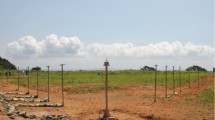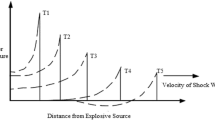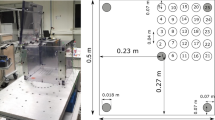Abstract
The propagation of blast and shock waves in confined environments is a complex phenomenon; yet, being able to derive valid predictions of such phenomena is highly relevant, for example, when it comes to the assessment of protection of personnel in military environments. This study looks at the propagation of blast waves inside a compound survival shelter. Experimental analyses are performed on a small-scale model of the actual configuration of the shelter subjected to the detonation of an explosive charge at different locations close to its entrance. Pressure-time signals are recorded on a number of locations in the model. A numerical model is also developed to complement the experimental programme, based on the explicit finite element (FE) code LS-DYNA. The recorded experimental data (e.g., pressure and impulse) are compared with the numerical predictions to validate the FE model. The authors discuss two different modelling approaches (the Lagrangian and the MM-ALE formulations) and analyse the influence of using a different number of ambient layers, the advection method, the time-step size, and level of discretisation. The proposed numerical model predicts and captures the relevant stages of the propagation of the shock wave very well, with error levels on the resulting specific impulse always lower than 19% when compared to the experimental observations.
















Similar content being viewed by others
References
Lecompte, D., De Schepper, R., Belkassem, B., Kakogiannis, D., Reymen, B., Vantomme, J.: A modular building-block system for lab-scale explosive testing of urban type configurations. 23rd Military Aspects of Blast and Shock, Oxford (2014)
Kinney, G.F., Graham, K.J.: Explosive Shocks in Air. Springer, New York (1985). https://doi.org/10.1007/978-3-642-86682-1
Baker, W.E., Cox, P.A., Westine, P.S., Kulesz, J.J., Strehlow, R.A.: Explosion Hazards and Evaluation. Elsevier Science B. V., Amsterdam (1983)
Julien, B., Sochet, I., Vaillant, T.: Impact of the volume of rooms on shock wave propagation within a multi-chamber system. Shock Waves 26, 87–108 (2016). https://doi.org/10.1007/s00193-015-0603-2
Smith, P.D., Whalen, G.P., Feng, L.J., Rose, T.A.: Blast loading on buildings from explosions in city streets. Proc. Inst. Civ. Eng. Struct. Build. 146, 47–55 (2001). https://doi.org/10.1680/stbu.2001.146.1.47
Ripley, R.C., von Rosen, B., Ritzel, D.V., Whitehouse, D.R.: Small-scale modeling of explosive blasts in urban scenarios. 21st International Symposium on Ballistics, Adelaide (2004)
Remmenikov, A.M., Rose, T.A.: Modelling blast loads on buildings in complex city geometries. Comput. Struct. 83, 2197–2205 (2005). https://doi.org/10.1016/j.compstruc.2005.04.003
Smith, P.D., Rose, T.A.: Blast wave propagation in city streets—an overview. Prog. Struct. Eng. Mater. 8, 16–28 (2006). https://doi.org/10.1002/pse.209
Fouchier, C., Laboureur, D., Youinou, L., Lapebie, E., Buchlin, J.M.: Experimental investigation of blast wave propagation in an urban environment. J. Loss Prev. Process Ind. 49, 248–265 (2017). https://doi.org/10.1016/j.jlp.2017.06.021
Skews, B.W., Law, W.R.: The propagation of shock waves in a complex tunnel system. J. S. Afr. Inst. Min. Metall. 91, 137–144 (1991)
Smith, P.D., Mays, G.C., Rose, T.A., Teo, K.G., Roberts, B.J.: Small scale models of complex geometry for blast overpressure assessment. Int. J. Impact Eng. 12, 345–360 (1992). https://doi.org/10.1016/0734-743X(92)90112-7
Rigas, F., Sklavounos, S.: Experimentally validated 3-D simulation of shock waves generated by dense explosives in confined complex geometries. J. Hazard. Mater. 121, 23–30 (2005). https://doi.org/10.1016/j.jhazmat.2005.01.031
Sauvan, P.E., Sochet, I., Trélat, S.: Analysis of reflected blast wave pressure profiles in a confined room. Shock Waves 22, 253–264 (2012). https://doi.org/10.1007/s00193-012-0363-1
Geretto, C., Yuen, S.C., Nurick, G.N.: An experimental study of the effects of degrees of confinement on the response of square mild steel plates subjected to blast loading. Int. J. Impact Eng. 79, 32–44 (2015). https://doi.org/10.1016/j.ijimpeng.2014.08.002
Anthistle, T., Fletcher, D.I., Tyas, A.: Characterisation of blast loading in complex, confined geometries using quarter symmetry experimental methods. Shock Waves 26, 749–757 (2016). https://doi.org/10.1007/s00193-016-0621-8
Salvado, F.C., Tavares, A.J., Teixeira-Dias, F., Cardoso, J.B.: Confined explosions: The effect of compartment geometry. J. Loss Prev. Process Ind. 48, 126–144 (2017). https://doi.org/10.1016/j.jlp.2017.04.013
Luccioni, B., Ambrosini, D., Danesi, R.: Blast load assessment using hydrocodes. Eng. Struct. 28, 1736–1744 (2006). https://doi.org/10.1016/j.engstruct.2006.02.016
Zyskowski, A., Sochet, I., Mavrot, G., Bailly, P., Renard, J.: Study of the explosion process in a small scale experiment—structural loading. J. Loss Prev. Process Ind. 17, 291–299 (2004). https://doi.org/10.1016/j.jlp.2004.05.003
Smith, P.D., Hetherington, J.G.: Blast and Ballistic Loading of Structures. Butterworth-Heinemann, Oxford (1994)
Ousji, H., Belkassem, B., Louar, M.A., Kakogiannis, D., Reymen, B., Pyl, L., Vantomme, J.: Parametric study of an explosive-driven shock tube as blast loading tool. Exp. Tech. 40, 1307–1325 (2016). https://doi.org/10.1111/ext.12179
Kingery, C.N., Bulmash, G.: Air-Blast Parameters from TNT Spherical Air Burst and Hemispherical Surface Burst, Technical Report ARBRL (TR-02555). Ballistic Research Laboratory, Maryland (1984)
U.S. Department of the Army, Fundamentals of protective design for conventional weapons, Technical manual (TM5-855-1), U.S. Army Engineer Waterways Experiment Station, Washington, DC (1986)
Slavik, T.P.: A coupling of empirical explosive blast loads to ALE air domains in LS-DYNA. IOP Conf. Ser.: Mater. Sci. Eng. 10, 012146 (2010). https://doi.org/10.1088/1757-899X/10/1/012146
Shuaib, M., Daoud, O.M.A.: Numerical analysis of RC slab under blast loads using the coupling of LBE and ALE method in LS-DYNA, fib Symposium, Cape Town (2016)
Livermore Software Technology Corporation, LS-DYNA User Manual: Volume I (Version R7.1), Livermore, CA (2014)
Consolazio, G.R., Chung, J.H., Gurley, K.R.: Impact simulation and full scale crash testing of a low profile concrete work zone barrier. Comput. Struct. 81, 1359–1374 (2003). https://doi.org/10.1016/S0045-7949(03)00058-0
Han, Y., Liu, H.: Finite element simulation of medium-range blast loading using LS-DYNA. Shock Vib. 2015, 631493 (2015). https://doi.org/10.1155/2015/631493
Alia, A., Souli, M.: High explosive simulation using multi-material formulations. Appl. Therm. Eng. 26, 1032–1042 (2006). https://doi.org/10.1016/j.applthermaleng.2005.10.018
Flanagan, D.P., Belytschko, T.: A uniform strain hexahedron and quadrilateral and orthogonal hourglass control. Int. J. Numer. Methods Eng. 17, 679–706 (1981). https://doi.org/10.1002/nme.1620170504
Livermore Software Technology Corporation, LS-DYNA User Manual: Volume II Material Models (Version R7.1), Livermore, CA (2014)
Federal Emergency Management Agency, Reference manual to mitigate potential terrorist attacks against buildings, FEMA 426, Department of Homeland Security, US (2003)
Mahmadi, K., Aquelet, N., Souli, M.: New mesh relaxation technique in multi-material ALE applications. Emerg. Technol. Fluids Struct. Fluid-Struct. Interact. 1, 135–140 (2004). https://doi.org/10.1115/PVP2004-2863
Youngs, D.L.: Time-dependent multi-material flow with large fluid distortion. Numer. Methods Fluids Dyn. 24, 273–285 (1982)
Benson, D.J.: Momentum advection on a staggered mesh. J. Comput. Phys. 100, 143–162 (1992). https://doi.org/10.1016/0021-9991(92)90316-Q
Van Leer, B.: Towards the ultimate conservative difference scheme. IV. A new approach to numerical convection. J. Comput. Phys. 23, 276–299 (1977). https://doi.org/10.1016/0021-9991(77)90095-X
Corporation, Livermore Software Technology: LS-DYNA Theory Manual. Livermore, CA (2006)
Schwer, L.: A brief introduction to coupling load blast enhanced with Multi-Material ALE: the best of both worlds for air blast simulation, 9th LS-DYNA Forum, Bamberg (2010)
Chang, S.Y., Huang, C.L.: A new family of explicit time integration methods. IOP Conf. Ser.: Mater. Sci. Eng. 10, 012145 (2010). https://doi.org/10.1088/1757-899X/10/1/012145
Courant, R., Friedrichs, K., Lewy, H.: On the partial difference equations of mathematical physics. IBM J. Res. Dev. 11, 215–234 (1967). https://doi.org/10.1147/rd.112.0215
Weibull, W.: Explosion of spherical charges in air: travel time, velocity of front, and duration of shock waves. Technical report X-127, Ballistic Research Laboratories, Aberdeen, MD (1950)
Schwer, L.E., Netherton, M.D., Stewart, M.G.: Comparisons of University of Newcastle free air blast data with Conwep and LS-DYNA simulations. 23rd Military Aspects of Blast and Shock, Oxford (2014)
Westine, P.S., Baker, W.E.: Energy solutions for predicting deformations in blast-loaded structures. Technical report, Southwest Research Institute, San Antonio, TX (1975)
Chen, G., Feldman, M.: Shock reflection–diffraction phenomena and multidimensional conservation laws. Proceedings of the 12th International Conference on Hyperbolic Problems: Theory, Numerics and Applications (2009)
Huang, Y., Willford, M.R., Schwer, L.E.: Validation of LS-DYNA MMALE with blast experiments. 12th International LS-DYNA Users Conference, Detroit (2012)
Acknowledgements
The authors acknowledge the technical advice and contributions of Frederik Coghe, Bruno Reymen, Peter Michiels, and Tony Tuts.
Author information
Authors and Affiliations
Corresponding author
Additional information
Communicated by C. Needham and A. Higgins.
Publisher's Note
Springer Nature remains neutral with regard to jurisdictional claims in published maps and institutional affiliations.
Rights and permissions
About this article
Cite this article
Caçoilo, A., Teixeira-Dias, F., Mourão, R. et al. Blast wave propagation in survival shelters: experimental analysis and numerical modelling. Shock Waves 28, 1169–1183 (2018). https://doi.org/10.1007/s00193-018-0858-5
Received:
Revised:
Accepted:
Published:
Issue Date:
DOI: https://doi.org/10.1007/s00193-018-0858-5




